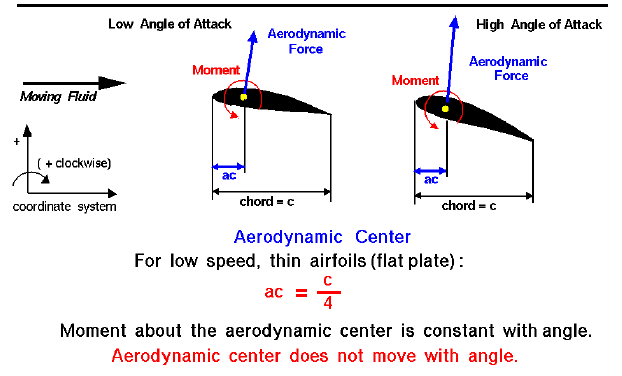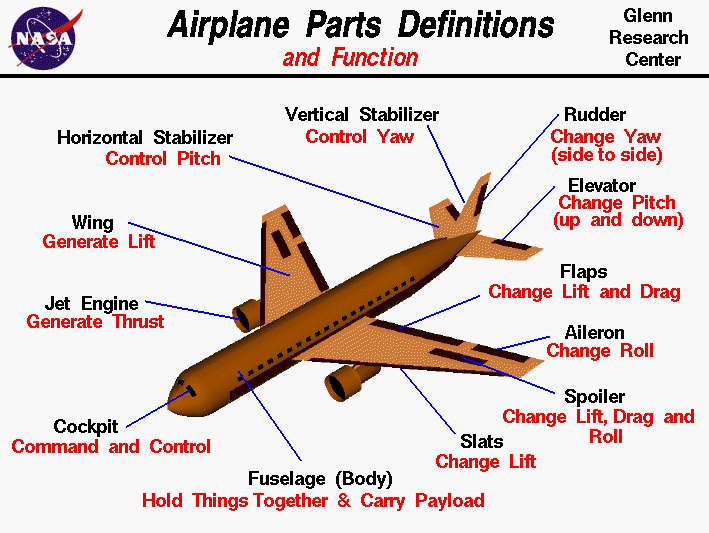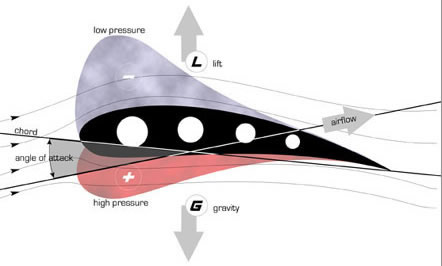THE THEORY OF AIRCRAFT AERODYNAMICS
AERODYNAMICS IS A BRANCH OF DYNAMICS CONCERNED WITH STUDYING THE MOTION OF AIR, PARTICULARLY WHEN IT INTERACTS WITH A MOVING OBJECT SUCH AS AN AIRCRAFT.
 |
 |
 |
Aerodynamics is closely related to fluid dynamics
|
 |
History
Images and stories of flight have appeared throughout recorded history, with perhaps the most noted of these being the story of Icarus and Daedalus. Although observations of some aerodynamic effects like wind resistance (a.k.a. drag) were recorded by the likes of Aristotle and Galileo Galilei, very little effort was made to develop governing laws for understanding the nature of flight prior to the 17th century.
Sir Isaac Newton was the first person to develop a theory of air resistance, arguably making him the world's first aerodynamicist. As part of that theory, Newton believed that drag was due to the dimensions of a body, the density of the fluid, and the velocity raised to the second power. These beliefs all turned out to be correct for low flow speeds. Newton also developed a law for the drag force on a flat plate inclined towards the direction of the fluid flow. Using F for the drag force, ρ for the density, S for the area of the flat plate, V for the flow velocity, and θ for the inclination angle, his law is expressed below.
Unfortunately, this equation is completely incorrect for the calculation of drag (unless the flow speed is hypersonic). Drag on a flat plate is closer to being linear with the angle of inclination as opposed to acting quadratically. This formula can lead one to believe that flight is more difficult than it actually is, and it may have contributed to a delay in manned flight.
Sir George Cayley is credited as the first person to separate the forces of lift and drag which are in effect on any flight vehicle. Cayley believed that the drag on a flying machine must be counteracted by a means of propulsion in order for level flight to occur. Cayley also looked to nature for aerodynamic shapes with low drag. One of the shapes he investigated were the cross-sections of trout. Although this may appear a bit comical in retrospect, the bodies of fish are actually shaped to produce very low resistance as they travel through water. As such, their cross-sections are sometimes very close to that of modern low drag airfoils.
These empirical findings led to a variety of air resistance experiments on various shapes throughout the 18th and 19th centuries. Drag theories were developed by Jean le Rond d'Alembert, Gustav Kirchhoff, and Lord Rayleigh. Equations for fluid flow with friction were developed by Claude-Louis Navier and George Gabriel Stokes. To simulate fluid flow, many experiments involved immersing objects in streams of water or simply dropping them off the top of a tall building. Towards the end of this time period Gustave Eiffel used his Eiffel Tower to assist in the drop testing of flat plates.
Of course, a more precise way to measure resistance is to place an object within an artificial, uniform stream of air where the velocity is known. The first person to experiment in this fashion was Francis Herbert Wenham, who in doing so constructed the first wind tunnel in 1871. Wenham was also a member of the first professional organization dedicated to aeronautics, the Royal Aeronautical Society of Great Britain. Objects placed in wind tunnel models are almost always smaller than in practice, so a method was needed to relate small scale models to their real-life counterparts. This was achieved with the invention of the dimensionless Reynolds number by Osbourne Reynolds. Reynolds also experimented with laminar to turbulent flow transition in 1883.
By the late 19th century, two problems were identified before heavier-than-air flight could be realized. The first was the creation of low-drag, high-lift aerodynamic wings. The second problem was how to determine the power needed for sustained flight. During this time, the groundwork was laid down for modern day fluid dynamics and aerodynamics, with other less scientifically inclined enthusiasts testing various flying machines with little success.
In 1889, Charles Renard, a French aeronautical engineer, became the first person to reasonably predict the power needed for sustained flight. Renard and German physicist Hermann von Helmholtz explored the wing loading of birds, eventually concluding that humans could not fly under their own power by attaching wings onto their arms. Otto Lilienthal, following the work of Sir George Cayley, was the first person to become highly successful with glider flights. Lilienthal believed that thin, curved airfoils would produce high lift and low drag.
Octave Chanute provided a great service to those interested in aerodynamics and flying machines by publishing a book outlining all of the research conducted around the world up to 1893. With the information contained in that book and the personal assistance of Chanute himself, the Wright brothers had just enough knowledge of aerodynamics to fly the first manned aircraft on December 17, 1903, just in time to beat the efforts of Samuel Pierpont Langley. The Wright brothers' flight confirmed or disproved a number of aerodynamics theories. Newton's drag force theory was finally proved incorrect. The first flight led to a more organized effort between aviators and scientists, leading the way to modern aerodynamics.
During the time of the first flights, Frederick W. Lanchester, Martin Wilhelm Kutta, and Nikolai Zhukovsky independently created theories that connected circulation of a fluid flow to lift. Kutta and Zhukovsky went on to develop a two-dimensional wing theory. Expanding upon the work of Lanchester, Ludwig Prandtl is credited with developing the mathematics behind thin-airfoil and lifting-line theories as well as work with boundary layers. Prandtl, a professor at Gottingen University, instructed many students who would play important roles in the development of aerodynamics like Theodore von Kármán and Max Munk.
As aircraft began to travel faster, aerodynamicists realized that the density of air began to change as it came into contact with an object, leading to a division of fluid flow into the incompressible and compressible regimes. In compressible aerodynamics, density and pressure both change, which is the basis for calculating the speed of sound. Newton was the first to develop a mathematical model for calculating the speed of sound, but it was not correct until Pierre-Simon Laplace accounted for the molecular behavior of gases and introduced the heat capacity ratio. The ratio of the flow speed to the speed of sound was named the Mach number after Ernst Mach, who was one of the first to investigate the properties of supersonic flow which included Schlieren photography techniques to visualize the changes in density. William John Macquorn Rankine and Pierre Henri Hugoniot independently developed the theory for flow properties before and after a shock wave. Jakob Ackeret led the initial work on calculating the lift and drag on a supersonic airfoil. Theodore von Kármán and Hugh Latimer Dryden introduced the term transonic to describe flow speeds around Mach 1 where drag increases rapidly. Because of the increase in drag approaching Mach 1, aerodynamicists and aviators disagreed on whether manned supersonic flight was achievable.
On September 30, 1935 an exclusive conference was held in Rome with the topic of high velocity flight and the possibility of breaking the sound barrier.Participants included von Kármán, Prandtl, Ackeret, Eastman Jacobs, Adolf Busemann, Geoffrey Ingram Taylor, Gaetano Arturo Crocco, and Enrico Pistolesi. The new research presented was impressive. Ackeret presented a design for a supersonic wind tunnel. Busemann gave perhaps the best presentation on the need for aircraft with swept wings for high speed flight. Eastman Jacobs, working for NACA, presented his optimized airfoils for high subsonic speeds which led to some of the high performance American aircraft during World War II. Supersonic propulsion was also discussed. The sound barrier was broken using the Bell X-1 aircraft twelve years later, thanks in part to those individuals.
By the time the sound barrier was broken, much of the subsonic and low supersonic aerodynamics knowledge had matured. The Cold War fueled an ever evolving line of high performance aircraft. Computational fluid dynamics was started as an effort to solve for flow properties around complex objects and has rapidly grown to the point where entire aircraft can be designed using a computer.
With some exceptions, the knowledge of hypersonic aerodynamics has matured between the 1960s and the present decade. Therefore, the goals of an aerodynamicist have shifted from understanding the behavior of fluid flow to understanding how to engineer a vehicle to interact appropriately with the fluid flow. For example, while the behavior of hypersonic flow is understood, building a scramjet aircraft to fly at hypersonic speeds has seen very limited success. Along with building a successful scramjet aircraft, the desire to improve the aerodynamic efficiency of current aircraft and propulsion systems will continue to fuel new research in aerodynamics.
Transonic flow
The term Transonic refers to a range of velocities just below and above the local speed of sound (generally taken as Mach 0.8–1.2). It is defined as the range of speeds between the critical Mach number, when some parts of the airflow over an aircraft become supersonic, and a higher speed, typically near Mach 1.2, when all of the airflow is supersonic. Between these speeds some of the airflow is supersonic, and some is not.
Supersonic flow
Supersonic aerodynamic problems are those involving flow speeds greater than the speed of sound. Calculating the lift on the Concorde during cruise can be an example of a supersonic aerodynamic problem.
Supersonic flow behaves very differently from subsonic flow. Fluids react to differences in pressure; pressure changes are how a fluid is "told" to respond to its environment. Therefore, since sound is in fact an infinitesimal pressure difference propagating through a fluid, the speed of sound in that fluid can be considered the fastest speed that "information" can travel in the flow. This difference most obviously manifests itself in the case of a fluid striking an object. In front of that object, the fluid builds up a stagnation pressure as impact with the object brings the moving fluid to rest. In fluid traveling at subsonic speed, this pressure disturbance can propagate upstream, changing the flow pattern ahead of the object and giving the impression that the fluid "knows" the object is there and is avoiding it. However, in a supersonic flow, the pressure disturbance cannot propagate upstream. Thus, when the fluid finally does strike the object, it is forced to change its properties -- temperature, density, pressure, and Mach number -- in an extremely violent and irreversible fashion called a shock wave. The presence of shock waves, along with the compressibility effects of high-velocity (see Reynolds number) fluids, is the central difference between supersonic and subsonic aerodynamics problems.
Hypersonic flow
In aerodynamics, hypersonic speeds are speeds that are highly supersonic. In the 1970s, the term generally came to refer to speeds of Mach 5 (5 times the speed of sound) and above. The hypersonic regime is a subset of the supersonic regime. Hypersonic flow is characterized by high temperature flow behind a shock wave, viscous interaction, and chemical dissociation of gas.
© AviationExplorer.com - The Website For Aviation Enthusiasts |




